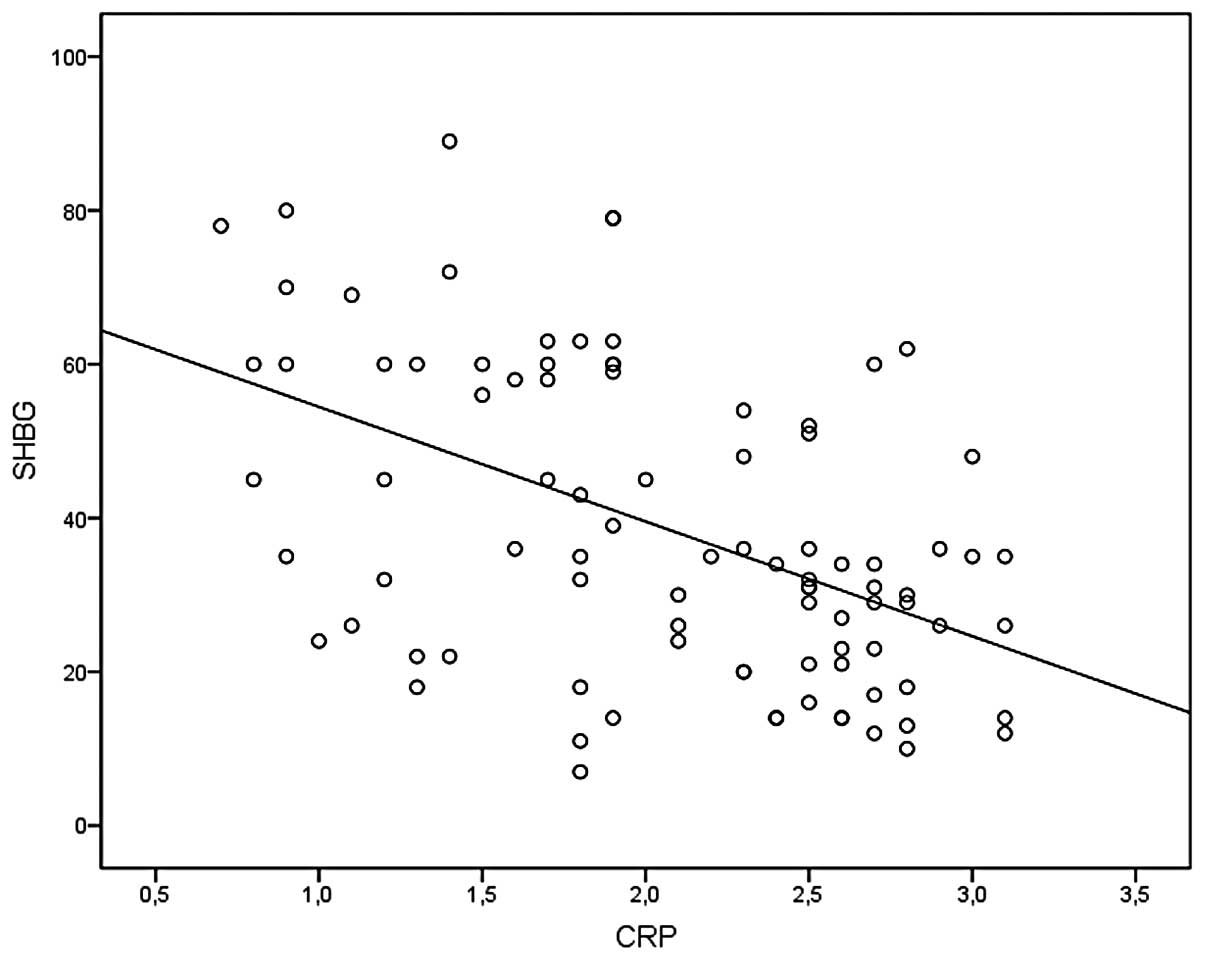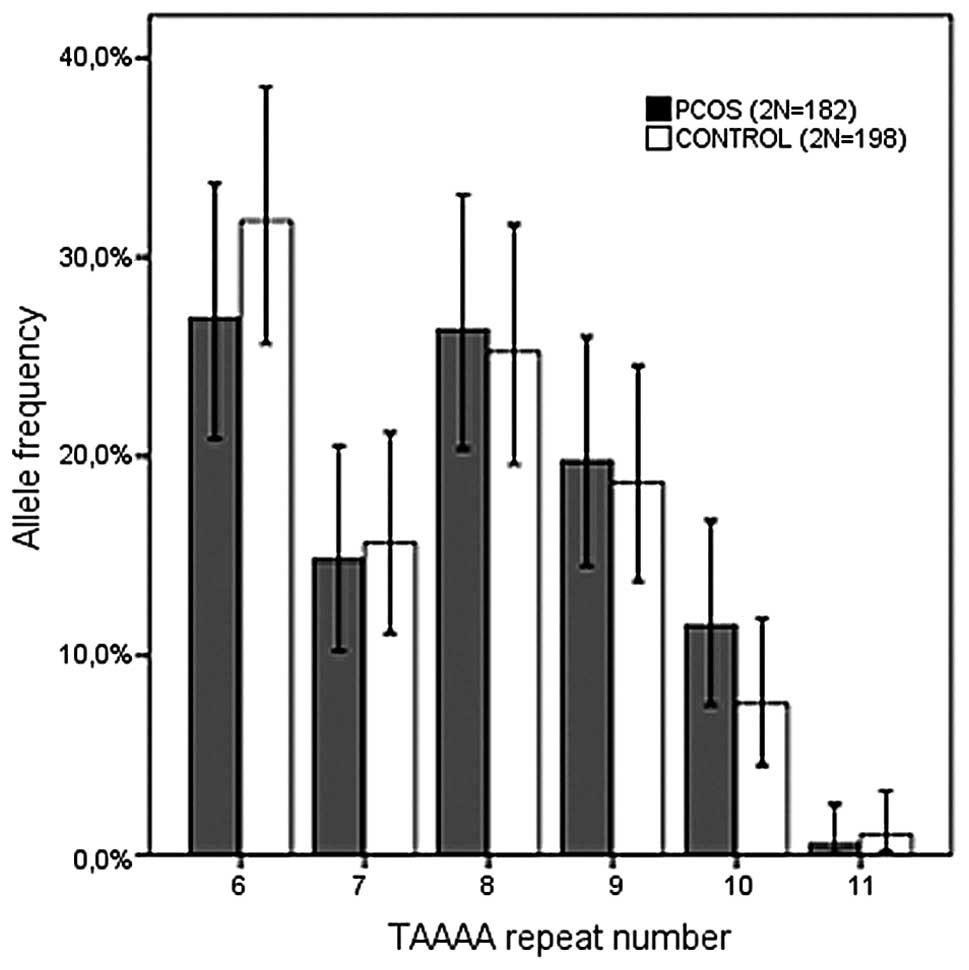|
1
|
Rotterdam ESHRE/ASRM-Sponsored PCOS
consensus workshop group. Revised 2003 consensus on diagnostic
criteria and long-term health risks related to polycystic ovary
syndrome (PCOS). Hum Reprod. 19:41–47. 2004. View Article : Google Scholar
|
|
2
|
Rotterdam ESHRE/ASRM-Sponsored PCOS
Consensus Workshop Group. Revised 2003 consensus on diagnostic
criteria and long-term health risks related to polycystic ovary
syndrome. Fertil Steril. 81:19–25. 2004. View Article : Google Scholar
|
|
3
|
Carmina E, Chu MC, Longo RA, Rini GB and
Lobo RA: Phenotypic variation in hyperandrogenic women influences
the finding of abnormal metabolic and cardiovascular risk
parameters. J Clin Endocrinol Metab. 90:2545–2549. 2005. View Article : Google Scholar : PubMed/NCBI
|
|
4
|
Boulman N, Levy Y, Leiba LR, Shachar S, et
al: Increased C-reactive protein levels in polycystic ovary
syndrome: a maker of cardiovascular disease. J Clin Endocrinol
Metab. 89:2160–2165. 2004. View Article : Google Scholar : PubMed/NCBI
|
|
5
|
Morin-Papunen L, Rautio K, Ruokonen A,
Hedberg P, Puukka M and Tapanainen JS: Metformin reduces serum
C-reactive protein levels in women with polycystic ovary syndrome.
J Clin Endocrinol Metab. 88:4649–4654. 2003. View Article : Google Scholar : PubMed/NCBI
|
|
6
|
Escobar-Morreale HF, Luque-Ramírez M and
González F: Circulating inflammatory markers in polycystic ovary
syndrome: a systematic review and metaanalysis. Fertil Steril.
95:1048–1058. 2011. View Article : Google Scholar
|
|
7
|
Toulis KA, Goulis DG, Mintziori G, et al:
Meta-analysis of cardiovascular disease risk markers in women with
polycystic ovary syndrome. Hum Reprod Update. 17:741–760. 2011.
View Article : Google Scholar : PubMed/NCBI
|
|
8
|
Brand JS, van der Tweel I, Grobbee DE,
Emmelot-Vonk MH and van der Schouw YT: Testosterone, sex
hormone-binding globulin and the metabolic syndrome: a systematic
review and meta-analysis of observational studies. Int J Epidemiol.
40:189–207. 2011. View Article : Google Scholar
|
|
9
|
Speroff L, Glass RH and Kase NG:
Anovulation and the polycystic ovary. Clinical Gynecologic
Endocrinology and Infertility. Lippincott, Wiliams & Wilkins;
Philadelphia, USA: pp. 487–521. 1999
|
|
10
|
Peter A, Kantartzis K, Machann J, et al:
Relationships of circulating sex hormone-binding globulin with
metabolic traits in humans. Diabetes. 59:3167–3173. 2010.
View Article : Google Scholar : PubMed/NCBI
|
|
11
|
Liao CH, Li HY, Yu HJ, et al: Low serum
sex hormone-binding globulin: marker of inflammation? Clin Chim
Acta. 413:803–807. 2012. View Article : Google Scholar : PubMed/NCBI
|
|
12
|
Bonnet F, Balau B, Malécot JM, et al: Sex
hormone-binding globulin predicts the incidence of hyperglycemia in
women: interactions with adiponectin levels. Eur J Endocrinol.
161:81–85. 2009. View Article : Google Scholar : PubMed/NCBI
|
|
13
|
Ding EL, Song Y, Manson JE, et al: Sex
hormone-binding globulin and risk of type 2 diabetes in women and
men. N Engl J Med. 361:1152–1163. 2009. View Article : Google Scholar : PubMed/NCBI
|
|
14
|
Xita N and Tsatsoulis A: Genetic variants
of sex hormone-binding globulin and their biological consequences.
Mol Cell Endocrinol. 316:60–65. 2010. View Article : Google Scholar
|
|
15
|
Hogeveen KN, Talikka M and Hammond GL:
Human sex hormone-binding globulin promoter activity is influenced
by a (TAAAA)n repeat element within an Alu sequence. J Biol Chem.
276:36383–36390. 2001. View Article : Google Scholar : PubMed/NCBI
|
|
16
|
Xita N, Tsatsoulis A, Chatzikyriakidou A
and Georgiou I: Association of the (TAAAA)n repeat polymorphism in
the sex hormone-binding globulin (SHBG) gene with polycystic ovary
syndrome and relation to SHBG serum levels. J Clin Endocrinol
Metab. 88:5976–5980. 2003. View Article : Google Scholar : PubMed/NCBI
|
|
17
|
Ferk P, Teran N and Gersak K: The (TAAAA)n
microsatellite polymorphism in the SHBG gene influences serum SHBG
levels in women with polycystic ovary syndrome. Hum Reprod.
22:1031–1036. 2007. View Article : Google Scholar
|
|
18
|
Cousin P, Calemard-Michel L, Lejeune H, et
al: Influence of SHBG gene pentanucleotide TAAAA repeat and D327N
polymorphism on serum sex hormone-binding globulin concentration in
hirsute women. J Clin Endocrinol Metab. 89:917–924. 2004.
View Article : Google Scholar : PubMed/NCBI
|
|
19
|
Liu Q, Gu W, Cui B, et al: The association
of TAAAAn repeat polymorphism in sex hormone-binding protein gene
with polycystic ovary syndrome in Chinese population. Endocrine.
34:62–67. 2008. View Article : Google Scholar : PubMed/NCBI
|
|
20
|
Alevizaki M, Saltiki K, Xita N, et al: The
importance of the (TAAAA)n alleles at the SHBG gene promoter for
the severity of coronary artery disease in postmenopausal women.
Menopause. 15:461–468. 2008. View Article : Google Scholar : PubMed/NCBI
|
|
21
|
Saltiki K, Stamatelopoulos K, Voidonikola
P, et al: Association of the SHBG gene promoter polymorphism with
early markers of atherosclerosis in apparently healthy women.
Atherosclerosis. 219:205–210. 2011. View Article : Google Scholar : PubMed/NCBI
|
|
22
|
Ferriman D and Gallwey JD: Clinical
assessment of body hair growth in women. J Clin Endocrinol Metab.
21:1440–1447. 1961. View Article : Google Scholar : PubMed/NCBI
|
|
23
|
Vermeulen A, Verdonck L and Kaufman JM: A
critical evaluation of simple methods for the estimation of free
testosterone in serum. J Clin Endocrinol Metab. 84:3666–3672. 1999.
View Article : Google Scholar : PubMed/NCBI
|
|
24
|
Friedewald WT, Levy RI and Fredericson DS:
Estimation of the concentration of low density lipoprotein
cholesterol without use of the ultracentrifuge. Clin Chem.
18:499–502. 1972.PubMed/NCBI
|
|
25
|
Tsatsoulis A: Developmental programming of
polycystic ovary syndrome: role of prenatal androgen excess.
Tsatsoulis A, Wyckoff J and Brown FM: Diabetes in Women:
Pathophysiology and Therapy. Humana Press; New York, NY: pp.
83–103. 2009, View Article : Google Scholar
|
|
26
|
Baldani DP, Skrgatić L, Goldstajn MS, et
al: Clinical and biochemical characteristics of polycystic ovary
syndrome in Croatian population. Coll Antropol. 36:1413–1418.
2012.
|
|
27
|
González F, Rote NS, Minium J and Kirwan
JP: Increased activation of nuclear factor kappaB triggers
inflammation and insulin resistance in polycystic ovary syndrome. J
Clin Endocrinol Metab. 91:1508–1512. 2006. View Article : Google Scholar : PubMed/NCBI
|
|
28
|
González F, Rote NS, Minium J and Kirwan
JP: Reactive oxygen species-induced oxidative stress in the
development of insulin resistance and hyperandrogenism in
polycystic ovary syndrome. J Clin Endocrinol Metab. 91:336–340.
2006. View Article : Google Scholar
|
|
29
|
González F, Rote NS, Minium J and Kirwan
JP: Evidence of proatherogenic inflammation in polycystic ovary
syndrome. Metabolism. 58:954–962. 2009. View Article : Google Scholar : PubMed/NCBI
|
|
30
|
González F, Nair KS, Daniels JK, et al:
Hyperandrogenism sensitizes leukocytes to hyperglycemia to promote
oxidative stress in lean reproductive-age women. J Clin Endocrinol
Metab. 97:2836–2843. 2012. View Article : Google Scholar : PubMed/NCBI
|
|
31
|
González F: Inflammation in polycystic
ovary syndrome: underpinning of insulin resistance and ovarian
dysfunction. Steroids. 77:300–305. 2012. View Article : Google Scholar :
|
|
32
|
Jain SK: Hyperglicemia can cause membrane
lipid peroxidation and osmotic fragility in human red blood cells.
J Biol Chem. 264:21340–21345. 1989.PubMed/NCBI
|
|
33
|
Aljada A, Thusu K, Amstrong D, Nicotera T
and Dandona P: Increased carbonylation of proteins in diabetes.
Diabetes. 44:113A1995.
|
|
34
|
Dandona P, Thusu K, Cook S, et al:
Oxidative damage to DNA in diabetes mellitus. Lancet. 347:444–445.
1996. View Article : Google Scholar : PubMed/NCBI
|
|
35
|
Stephens JM, Butts MD and Pekala PH:
Regulation of transcription factor mRNA accumulation during 3T3-L1
preadipocytedifferentiation by tumour necrosis factor-alpha. J Mol
Endocrinol. 9:61–72. 1992. View Article : Google Scholar : PubMed/NCBI
|
|
36
|
Zwaka TP, Hombach V and Torzewski J:
C-reactive protein-mediated low density lipoprotein uptake by
macrophages: implications for atherosclerosis. Circulation.
103:1194–1197. 2001. View Article : Google Scholar : PubMed/NCBI
|
|
37
|
Simó R, Barbosa-Desongles A, Sáez-Lopez C,
et al: Molecular mechanism of TNFα-induced down-regulation of SHBG
expression. Mol Endocrinol. 26:438–446. 2012. View Article : Google Scholar
|
















